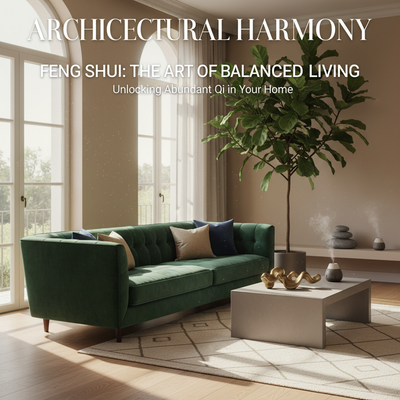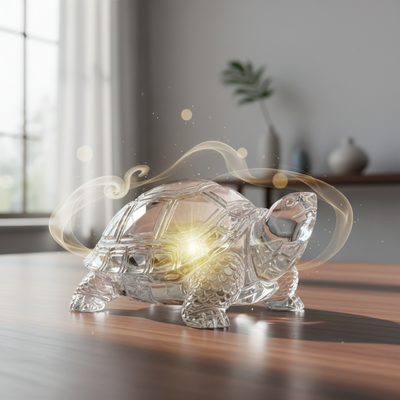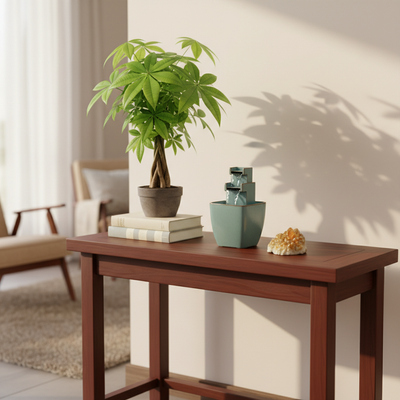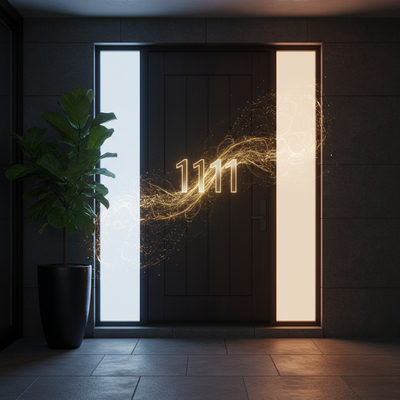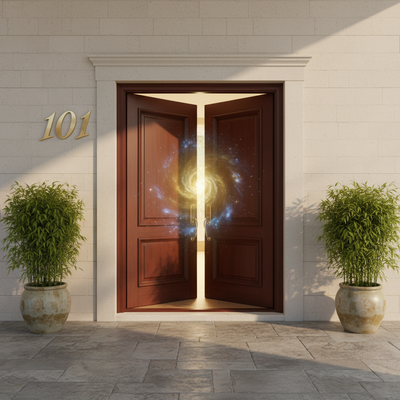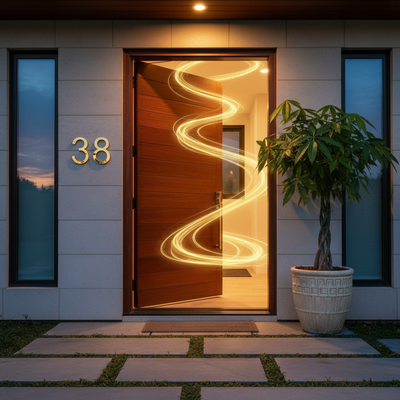The question comes up in almost every consultation: "Are artificial plants bad for bedroom feng shui?" It's a topic that creates heated debate, with lots of conflicting advice. The traditional, strict answer is a quick 'yes'. But the modern, practical answer is much more complex. While classic feng shui correctly values the vibrant life energy, or 'Sheng Chi', of living plants, the reality of modern life needs a more flexible approach. Let's be clear: a high-quality, well-maintained artificial plant is much better for your bedroom's energy than a struggling, ignored, or dying real one. The energy of failure and decay is far more harmful than the neutral energy of a beautiful fake plant. This guide will move beyond simple rules and walk you through the expert principles for making the right choice, ensuring your bedroom becomes a true sanctuary of rest and renewal.
The Great Debate

To understand the controversy surrounding artificial plants, we must first understand the core concept of Chi (or Qi), the life force energy that flows through everything in the universe. In feng shui, our goal is to build positive Chi and reduce the negative. Plants play a crucial role in this energy dance, but not all energy is the same.
Sheng Chi vs. Si Chi
At the heart of the plant debate are two opposite types of energy: Sheng Chi and Si Chi.
Sheng Chi is the energy of life itself. It is the vibrant, upward-moving, and nourishing force given off by healthy, growing things. Think of a thriving forest, a sun-filled garden, or a strong houseplant pushing out new leaves. This is the energy that brings vitality, growth, and good fortune into a space. Traditionally, real, healthy plants are the ultimate creators of Sheng Chi, which is why they are so valued in feng shui practice. They actively participate in the energy of a room, cleaning the air and lifting the spirit.
Si Chi, on the other hand, is stagnant, dead, or draining energy. It is low, heavy, and contributes to feelings of tiredness, depression, and being 'stuck'. A dying, bug-infested plant is a powerful source of Si Chi. Likewise, a cheap, dusty, plastic plant that has been forgotten in a corner also collects and gives off this stagnant energy. It represents neglect and a lack of life.
The Traditionalist Viewpoint
Classic feng shui masters were purists. In their view, anything 'fake' or imitation was a representation of illusion and lies. An artificial plant, no matter how realistic, fundamentally lacks the essential Sheng Chi needed to nourish a space and its inhabitants. It was seen as a substitute for life, but not life itself. This perspective holds that placing an imitation of nature in your home invites a similar imitation of health, wealth, and happiness, rather than the real thing. For traditionalists, the absence of Sheng Chi makes an artificial plant, at best, an energetically inactive object and, at worst, a symbol of stagnation.
The Modern Perspective
The contemporary feng shui perspective, which we practice, is less about rigid rules and more about intention, quality, and practicality. We recognize that the energy of an object is not solely defined by its origin but is also deeply influenced by its quality, the care it receives, and the intention behind its use.
In this modern view, a beautiful, super-realistic silk plant, kept perfectly clean and placed with a positive intention, can hold a neutral-to-positive energetic charge. It becomes a symbol of your desire for nature and growth. This is especially true in situations where a real plant is simply not possible—such as in a bedroom with no natural light, for individuals with severe allergies, or for those with demanding lifestyles that make plant care impossible. The intention to bring beauty and a sense of nature into the space, combined with the act of maintaining that object's cleanliness and beauty, fills it with positive energy.
The QI FLOW Method
Theory is one thing, but real-world application is where the truth of these principles is revealed. At THE QI FLOW, we have seen firsthand how the strategic use of high-quality artificial plants can transform a space from draining to nurturing. A case study of one of our clients, whom we'll call Sarah, perfectly illustrates this.
The Client's Challenge
Sarah contacted us in a state of quiet desperation. Her bedroom, her supposed sanctuary, felt heavy, stressful, and lifeless. It was a north-facing room with a single small window that received almost no direct natural light. A dedicated nature lover, she had repeatedly tried to bring life into the space with real plants—ferns, snake plants, pothos—but one by one, they all withered and died. Each dead plant felt like a personal failure, adding to her stress and contributing to a persistent low mood. She described the feeling upon entering her bedroom as "walking into a sigh." The room felt heavy, stagnant, and completely devoid of joy.
Our Energy Assessment
During our consultation, the team at THE QI FLOW immediately identified the primary energy drain. It wasn't the lack of real plants; it was the presence of dying ones. The drooping, yellowing leaves and dry soil were broadcasting powerful Si Chi (stagnant energy) throughout the room. This energy of decay and failure was far worse than having no plants at all. It was a constant, draining reminder of her inability to sustain life in her most personal space. Furthermore, the absence of any vibrant green color, a hue associated with the Wood element representing health and growth, made the space feel even less nurturing and supportive. The energy was stuck, and so was Sarah.
The Strategic Solution
Our recommendation was clear and, for Sarah, revolutionary. We advised her to remove the dying plants immediately and to stop trying to force life where it couldn't thrive naturally. Instead, we proposed a strategic solution using high-quality artificial plants. We weren't talking about the shiny, obviously plastic plants from a discount store. We specified super-realistic silk plants.
We selected a pair of tall, elegant faux Fiddle Leaf Figs with real wood trunks and soft, broad silk leaves. We placed them on either side of her small window, creating a beautiful frame that gave the illusion of a lush view. The upward growth of the Fiddle Leaf Figs introduced an energy of aspiration and vitality. On her dresser, we added a small, lush-looking faux Boston Fern, its delicate fronds softening the hard lines of the furniture. We emphasized the importance of choosing plants with rounded leaves to promote a gentle, nurturing flow of Chi.
The Restful Result
The transformation was almost immediate. Within a week, Sarah reported feeling a "noticeable shift" in the room's energy. In her own words, "The room suddenly feels lighter, more hopeful. I can breathe again. I no longer feel that sense of dread when I open my bedroom door." The visual cue of lush, healthy 'greenery' provided the psychological and energetic benefits of the Wood element without the associated stress and Si Chi of failing plants. Her sleep improved, and she began to see her bedroom as a restful sanctuary for the first time in years. This case is a testament to a core principle we champion: a thoughtful, high-quality artificial element, placed with clear intention, can absolutely support and enhance good feng shui, proving superior to a natural element that is a source of stress and stagnant energy.
Choosing Friendly Plants
Once you've decided to embrace artificial plants, the selection process is crucial. Not all fake plants are created equal, and choosing the right one is the difference between introducing a positive symbol and a dust-collecting piece of plastic. This is your definitive guide to selecting plants that will genuinely enhance your bedroom's energy.
Material Matters
The material of your artificial plant is extremely important. The goal is to mimic the gentle, life-affirming energy of nature as closely as possible.
High-quality silk and modern fabric blends are the superior choice. They have a softness and matte finish that more accurately copies the texture of real leaves, allowing light to interact with them in a natural way. Many premium artificial plants also incorporate real wood trunks or bamboo stalks, which further ground the object and connect it to the Wood element.
Conversely, avoid cheap, shiny, hard plastic plants. Their unnatural shine and rigid forms create a harsh, jarring energy. They look and feel fake, reinforcing the very illusion and stagnation that traditional feng shui warns against. Their material holds and attracts dust, quickly becoming a source of Si Chi if not carefully cleaned.
Good Shapes
In feng shui, shape and form dictate how Chi flows. For a bedroom, a space dedicated to rest and relationships, you want energy that is soft, gentle, and nurturing.
- Soft, rounded leaves are ideal. They promote a smooth and calm flow of Chi. Think of plants like a faux Money Plant (Pilea peperomioides), Rubber Plant, Fiddle Leaf Fig, or Calathea. Their broad, circular leaves are welcoming and gentle on the eyes.
- Upward growth symbolizes vitality and reaching for new heights. Plants that appear to be growing upwards, like a well-shaped Fiddle Leaf Fig or a faux Monstera on a moss pole, introduce an energy of positive growth and aspiration.
- Lush and full appearance represents abundance and prosperity. A plant that looks healthy and full symbolizes a life of fullness and vibrancy. Avoid sparse, scraggly-looking artificial plants.
Plants to Avoid
Just as important as knowing what to choose is knowing what to avoid, especially in the vulnerable environment of the bedroom.
- Sharp, spiky plants are a major feng shui mistake for the bedroom. This includes most faux Cacti, many Agaves, and some sharp-leafed Snake Plants (Sansevieria). Their pointed shapes create "Sha Chi," or "cutting energy." This aggressive, piercing energy is disruptive to the peaceful, yin energy required for restful sleep and harmonious relationships.
- Dried or preserved plants, including dried flowers, potpourri, or preserved grasses, are a definite no. From a feng shui perspective, these are dead. They represent the end of a life cycle and hold dead, stagnant energy. Placing these in your bedroom is like inviting decay into your personal sanctuary.
- Dusty, broken, or faded plants must be avoided or immediately fixed. A plant, real or artificial, that is covered in dust, has broken stems, or is faded from the sun is a magnet for Si Chi. It symbolizes neglect and decline. Regular cleaning is not just a chore; it's an essential act of energetic maintenance.
Real vs. Artificial Table
To help you make the best decision for your unique situation, we've created a simple comparison chart.
| Feature | Healthy Real Plant | High-Quality Silk Plant | Cheap Plastic Plant |
|---|---|---|---|
| Chi Quality | Excellent (Sheng Chi) - Actively purifies air & energy. | Neutral to Positive - Holds energy based on care & intention. | Negative (Si Chi) - Feels lifeless, accumulates dust. |
| Symbolism | Growth, Vitality, Life | Aspiration for Nature, Stability | Illusion, Stagnation, "Fakeness" |
| Maintenance | High (Watering, light, feeding) | Low (Regular dusting/cleansing is essential) | Very Low (Often neglected, becoming a dust magnet) |

Activating Your Plant
Simply buying a high-quality artificial plant and placing it in your room is only half the process. To truly transform it from a mere decorative object into a meaningful energetic tool, you must "activate" it. This simple ritual cleanses the plant of any stagnant energy and fills it with your personal, positive intention.
Why Activation is Necessary
Think about the journey your new plant has taken. It was manufactured in a factory, stored in a warehouse, and shipped across long distances before arriving in your home. Along the way, it can accumulate stagnant, chaotic, or neutral energy from its environment and the many hands that touched it. The process of cleansing and activation is like a reset button. It wipes the energetic slate clean and "wakes up" the object, making it receptive to the positive purpose you have for it in your sacred space.
A 3-Step Ritual
This ritual is simple, accessible, and can be done in just a few minutes. Approach it not as a task, but as a mindful moment of connection with your home.
-
Step 1: The Physical Cleanse. This is the foundation. Gently wipe down every leaf, stem, and the pot with a soft, damp cloth. As you do this, focus on the act of caring for the object. This is not just dusting; it is an act of respect for the item you are welcoming into your home. This physical cleaning removes not only dust but also the first layer of energetic residue.
-
Step 2: The Energetic Cleanse. After the physical cleaning, it's time to clear any remaining subtle, stagnant energy. You can choose the method that feels most right to you:
- Sound Cleansing: The vibration of sound is a powerful tool for breaking up energetic blockages. Ring a small bell, a chime, or a singing bowl near the plant. Let the sound wash over it, visualizing the vibrations shaking loose any old, stuck energy.
- Sunlight or Moonlight: Nature provides the most powerful cleansing energy. Place your artificial plant in the gentle morning sun or in the light of a full moon for a few hours. Allow the light to "charge" it, filling it with pure, natural energy.
- Intention: The power of your mind is your greatest tool. If other methods aren't available, simply hold your hands a few inches away from the plant. Close your eyes and visualize a brilliant, white or golden light pouring from your hands, surrounding the plant and dissolving any and all negativity.
-
Step 3: Setting Your Intention. This is the final and most important step. With the plant now cleansed, you can program it with a purpose. Hold the plant or gently touch its leaves. Take a deep breath and speak your intention for it, either aloud or in your mind. Be specific and positive. You might say something like, "We welcome this symbol of nature into our bedroom. May you bring an energy of peace, vibrant health, and deep, restful sleep to this space. May you remind us of growth and renewal."
Strategic Placement
Now that you have chosen and activated your plant, the final step is placing it correctly. Where you put your artificial plant in the bedroom is not random; strategic placement can amplify its positive effects and ensure it supports, rather than disrupts, the room's energy.
Golden Placement Rules
Before consulting any maps or specific corners, follow these universal rules for plant placement in the bedroom.
- Do not overcrowd. Less is more. A single, beautiful statement plant or a pair of smaller ones is far more powerful than a cluttered, chaotic indoor jungle. Overcrowding can create stagnant Chi.
- Keep away from the bed. Avoid placing any plants, real or artificial, directly above your headboard or on the bedside table right next to where you sleep. The active, upward energy of a plant symbol, even an artificial one, can be too stimulating and may disrupt restful sleep.
- Ensure visibility. Place your plants where you can easily see and appreciate them from your bed or as you move about the room. An object's feng shui benefit is partly derived from your conscious interaction with it.
Using the Bagua Map
For more targeted placement, we can use the Bagua, the energetic map of your space. To apply it to your bedroom, stand at the doorway looking into the room. The far-left corner is your Wealth area, the far-right is your Relationship area, and so on.
- Wealth & Prosperity Corner (Far Left): This is an excellent spot for a faux Money Plant or any artificial plant with lush, rounded leaves that looks full and abundant. Placing a symbol of growth here can help activate the energy of wealth and opportunity.
- Health & Family Corner (Middle Left): The Wood element governs this area, making it a natural home for a plant. A vibrant, healthy-looking faux plant placed here can help to ground and support the energy of physical health and harmonious family connections.
- Fame & Reputation Corner (Far Back, Center): This area is associated with the Fire element and your public self. A taller, upward-reaching artificial plant, like the faux Fiddle Leaf Fig we used for Sarah, can symbolize a rising reputation, recognition, and success.
The Relationship Corner
Special care should be taken with the Relationship Corner (Kun), located in the far-right corner from the door. This area is deeply connected to your primary partnership or your ability to attract one. Placing a single object here can accidentally symbolize and reinforce solitude. If you wish to use plants in this area, it is highly recommended to use a pair of identical small plants. Two matching faux succulents or two small, matching ferns placed side-by-side create a powerful symbol of a balanced, equal, and harmonious union.
Create a Nurturing Bedroom
The debate over artificial plants in bedroom feng shui is settled not by ancient rules, but by modern wisdom. The quality of the object, the cleanliness you maintain, and the positive intention you bring to it are what truly define its energetic impact. A beautiful, well-cared-for silk plant can be a powerful ally in creating a space that feels alive and supportive, especially where nature itself cannot thrive. Ultimately, the best feng shui for your bedroom is a space that feels restful, beautiful, and deeply nurturing to you. Trust your intuition, use these principles as your guide, and create the sanctuary you deserve.
